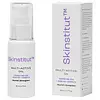What's inside
What's inside
 Key Ingredients
Key Ingredients

 Benefits
Benefits

 Concerns
Concerns

No concerns
 Ingredients Side-by-side
Ingredients Side-by-side

Carthamus Tinctorius Seed Oil
MaskingHelianthus Annuus Seed Oil
EmollientSimmondsia Chinensis Seed Oil
EmollientPunica Granatum Seed Oil
EmollientMacadamia Integrifolia Seed Oil
Skin ConditioningCarthamus Tinctorius Seed Oil, Helianthus Annuus Seed Oil, Simmondsia Chinensis Seed Oil, Punica Granatum Seed Oil, Macadamia Integrifolia Seed Oil, Tocopherol, Rosa Canina Flower Oil, Olea Europaea Fruit Oil, Pelargonium Crispum Leaf Oil, Litsea Cubeba Fruit Oil, Ubiquinone, Juniperus Communis Fruit Oil, Calendula Officinalis Flower Extract
Helianthus Annuus Seed Oil
EmollientJojoba Esters
EmollientVitis Vinifera Seed Oil
EmollientSimmondsia Chinensis Seed Oil
EmollientPunica Granatum Seed Oil
EmollientPhytosteryl Macadamiate
Skin ConditioningPhytosterols
Skin ConditioningMalus Domestica Fruit Cell Culture Extract
Skin ConditioningVitis Vinifera Fruit Cell Extract
Skin ConditioningCitrus Limon Leaf Cell Extract
Skin ConditioningSqualene
EmollientAscorbyl Palmitate
AntioxidantTocopherol
AntioxidantIsomalt
HumectantPhospholipids
Skin ConditioningXanthan Gum
EmulsifyingCitrus Reticulata Peel Oil
MaskingCinnamomum Camphora Wood Oil
MaskingLitsea Cubeba Fruit Oil
MaskingEthyl Linalool
MaskingLimonene
PerfumingCitral
PerfumingHelianthus Annuus Seed Oil, Jojoba Esters, Vitis Vinifera Seed Oil, Simmondsia Chinensis Seed Oil, Punica Granatum Seed Oil, Phytosteryl Macadamiate, Phytosterols, Malus Domestica Fruit Cell Culture Extract, Vitis Vinifera Fruit Cell Extract, Citrus Limon Leaf Cell Extract, Squalene, Ascorbyl Palmitate, Tocopherol, Isomalt, Phospholipids, Xanthan Gum, Citrus Reticulata Peel Oil, Cinnamomum Camphora Wood Oil, Litsea Cubeba Fruit Oil, Ethyl Linalool, Limonene, Citral
 Reviews
Reviews

Ingredients Explained
These ingredients are found in both products.
Ingredients higher up in an ingredient list are typically present in a larger amount.
Helianthus Annuus Seed Oil is the oil derived from the seeds of a Sunflower. Sunflower seed oil is non-fragrant. It is an emollient, meaning it helps to soften the skin.
Sunflower seed oil contains many fatty acids. The fatty acids found in sunflower seeds include (from highest amount to least): linoleic acid, myristic acid, palmitic acid, stearic acid, arachidic acid, oleic acid, and linolenic acid.
These fatty acids help the skin create ceramides. Ceramides play a role in repairing the skin barrier.
Helianthus Annuus Seed Oil helps moisturize the skin. This in turn helps the skin look more rejuvenated and smoother.
Sunflowers are rich in vitamin E.
Historians believe Indigenous cultures of North America domesticated sunflowers before corn. Thus they relied on sunflower oil for a variety of uses. One such use is moisturizing skin and hair.
Sunflower seed oil may not be fungal acne safe. We recommend speaking with a professional if you have any concerns.
Learn more about Helianthus Annuus Seed OilLitsea Cubeba Fruit Oil is a fragrance and is an oil.
Punica Granatum Seed Oil is created from the seeds of the pomegranate. Pomegranate seed oil helps hydrate the skin, is anti-inflammatory, and contains antioxidants.
Pomegranates are rich in fatty acids, including an unsaturated fatty acid by the name of Punicic acid. Other components of pomegranates include Vitamin E, Vitamin C, and bioactive lipids such as phytosterols, phospholipids, and triterpenes. Punicic acid helps soothe inflammation.
As an emollient, pomegranate oil creates a thin film on the skin. This film helps prevent moisture loss, keeping your skin hydrated.
Learn more about Punica Granatum Seed OilThis oil comes from the seeds of the desert shrub called Jojoba. It is more commonly known as jojoba oil, a non-comedogenic oil.
Jojoba oil does not contain fragrance and has many fatty-acids, making it a great soothing ingredient.
It also contains Vitamin E, a great moisturizing ingredient. Vitamin E is also an antioxidant and protects your skin against oxidative damage.
This ingredient humectant properties, meaning it helps draw moisture from the air. This helps keep your skin hydrated.
While jojoba has antibacterial properties, it is only able to kill some strains of bacteria.
Studies also show it helps in wound healing. In fact, Indigenous cultures have used jojoba as a moisturizer and to help treat burns for centuries.
Fun fact: Jojoba oil similar to natural human skin sebum, so it has a great effect on dry skin. It is also promising with helping to regulate sebum production.
Due to its fatty acid content, Jojoba oil may not be fungal acne safe. We recommend speaking with a professional if you have any concerns.
Learn more about Simmondsia Chinensis Seed OilTocopherol (also known as Vitamin E) is a common antioxidant used to help protect the skin from free-radicals and strengthen the skin barrier. It's also fat soluble - this means our skin is great at absorbing it.
Vitamin E also helps keep your natural skin lipids healthy. Your lipid skin barrier naturally consists of lipids, ceramides, and fatty acids. Vitamin E offers extra protection for your skin’s lipid barrier, keeping your skin healthy and nourished.
Another benefit is a bit of UV protection. Vitamin E helps reduce the damage caused by UVB rays. (It should not replace your sunscreen). Combining it with Vitamin C can decrease sunburned cells and hyperpigmentation after UV exposure.
You might have noticed Vitamin E + C often paired together. This is because it is great at stabilizing Vitamin C. Using the two together helps increase the effectiveness of both ingredients.
There are often claims that Vitamin E can reduce/prevent scarring, but these claims haven't been confirmed by scientific research.
Learn more about Tocopherol